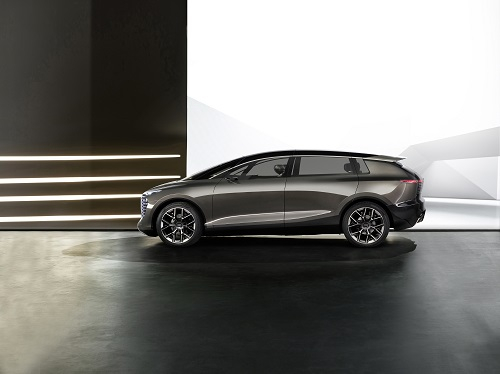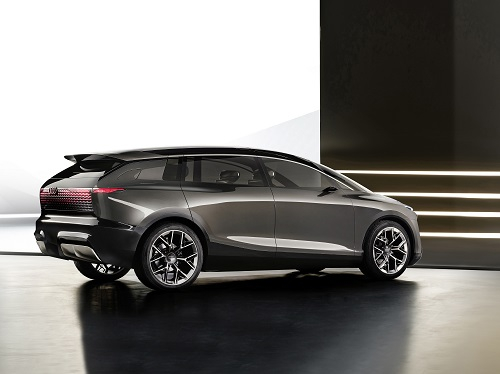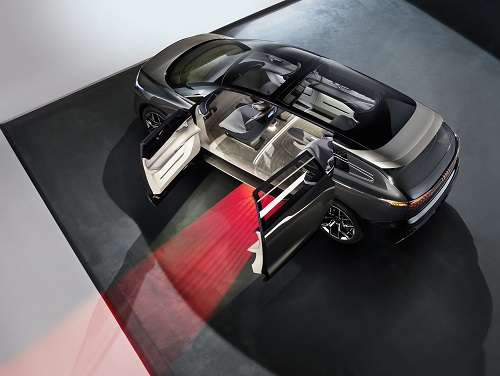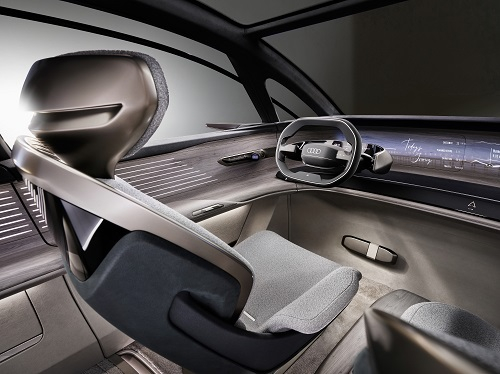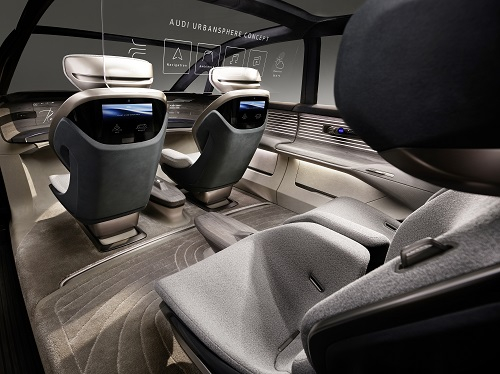Audi is presenting the Audi urbansphere concept car. Designers and engineers have created the Audi urbansphere primarily for use in traffic of Chinese megacities. In these metropolitan areas, where personal space is in particularly short supply, the concept car offers the largest interior space of any Audi to date. In addition, it intelligently coordinates this with technologies and digital services that appeal to all the senses and thus offer a new quality of experience.
The development process took place in close collaboration between Audi’s design studios in Beijing and its headquarters in Ingolstadt. For the first time, potential customers in China also took part, contributing their own desires and experiences to the development process (known as “co-creation”).
The result of this process can be seen in the Audi urbansphere concept, above all in the interior. As such, the spacious automobile acts as a lounge on wheels and mobile office – the vehicle serves as a third living space during the hours spent in traffic. To this end, the Audi urbansphere combines the luxury of complete privacy with a comprehensive range of high-tech features on board, even during the daily rush hour. Level 4 automated driving technology transforms the interior without a steering wheel, pedals, or displays into a mobile interactive space that opens up to the offerings of a comprehensive digital ecosystem.
Audi skysphere, Audi grandsphere, and Audi urbansphere are the three concept cars that the brand with the four rings is using to showcase its vision of the premium mobility of tomorrow. Audi is creating a vehicle experience that goes far beyond the purpose of merely spending time in a car to get from point A to point B.
In August 2021, Audi debuted the electrically-powered skysphere concept roadster – the spectacular vision of an autonomous GT that transforms itself into a self-driving sports car with a variable wheelbase.
Just a few weeks later, Audi unveiled the second model in the sphere series, the Audi grandsphere concept, at the IAA 2021. This large, prestigious four-seater saloon exemplified the brand’s ambition to define the future of progressive luxury.
What both concept cars have in common with the Audi urbansphere is that the entire concept is derived from the ability to drive in a level 4 autonomous vehicle. This is a technology that Audi is working towards introducing in the second half of the decade together with CARIAD, the Volkswagen Group’s software think tank
Even at first glance, the Audi urbansphere concept reveals itself as the largest model in the sphere family, indeed of all Audi concept cars to date. Its grand dimensions – 5,510mm long, 2,010mm wide, and 1,780mm tall – place it in the upper echelons of the automotive world, yet the Audi urbansphere concept radically breaks with the conventions of the segment.
This is because it has been systematically designed from the inside out, as it were, around its passengers. Consequently, the most important dimension for passengers is the unrivalled wheelbase of 3,400mm. The interior of the Audi urbansphere is not subject to the conventional maxim of squeezing as many seats, storage compartments, and functional elements as possible into a space limited by the physics of driving. Instead, it primarily responds to the passengers’ need to be able to experience generous space as a distinctive element of comfort.
The Audi urbansphere not only frees the driver from the burden of driving whenever possible, but at the same time offers everyone on board a wide variety of options to use this freedom to enjoy customizable experiences – communication or relaxation, work, or a retreat into a private sphere when desired. The Audi urbansphere concept itself also transforms from merely an automobile into a platform for groundbreaking experiences.
Thanks to Audi’s own options and the ability to integrate digital services from other providers, the possibilities are nearly endless. These can be used to access a wide range of services related to the current trip. The vehicle also takes care of everyday tasks that go beyond the ride itself – such as making dinner reservations or shopping online from the car. In addition, the autonomous Audi urbansphere concept picks up its passengers at home and independently takes care of finding a parking space and charging the battery.
Customized infotainment offerings are also available, such as the seamless integration of onboard streaming from music and video providers the customer already uses. In an additional step, Audi will make personalized and exclusive options available in the future – concerts, cultural events, or even sporting events that customers will be invited to.
The word “sphere” in the name already suggests that the focus of the Audi skysphere, grandsphere, and urbansphere concept cars is on the inner space, the interior. It is no longer the powertrain or the driving dynamics that are at the top of the list of requirements for this new generation of cars. Instead, the interior becomes the foundation for design and technology. And this means that it transforms into the passenger’s sphere of life and experience on the road.
Their needs and desires shape this space, its architecture, and all of the integrated functions. As a result of this shift, the design process itself also changes. At the beginning of all discussions, the focus is on the interior. Only then are the package, exterior lines and proportions designed, which, together with the technological specifications, turn the automobile into a complete work of art.
A grand, and undoubtedly self-assured, appearance – one’s first encounter with the Audi urbansphere concept is certain to leave an impression. A length of five and a half metres, its height of almost 1,780mm, and its width of more than two metres are undoubtedly prestigious enough to rub shoulders with the automotive elite.
The flowing silhouette of the vehicle body features traditional Audi shapes and elements, but are combined here to create a new composition – the distinctive Singleframe with the digital eyes of the adjacent lighting units. Viewed from the side, is the widely curved, dynamic roof arch, a massive sill that conceals the battery unit, and large 24-inch wheels. They reference an icon of the 90s – the Audi Avus concept car. The six double spokes simultaneously convey lightweight design and stability, reminiscent of functional motorsport wheels and the Bauhaus tradition of the brand’s design.
The implied wedge shape of the vehicle body is emphasized by the large, flat windshield. At the front and also at the rear, there are large digital lighting surfaces that leave their mark on the design and at the same time serve as communication elements.
The Audi urbansphere defies classification into conventional vehicle categories. Nevertheless, it reveals itself to be a typical Audi at first glance. The similarities to the Audi grandsphere concept are particularly eye-catching. The monolithic design of the vehicle body is common to these two concept cars, as is the sculpted, soft shape of the wheel arches. A long wheelbase of well over three metres and short overhangs indicate that this is an electric vehicle. Elegance, dynamism, an organic design language – these are the attributes that immediately spring to mind despite the stately proportions of the Audi urbansphere, just as they do in the significantly flatter grandsphere.
The front end features an innovative interpretation of the Singleframe that defines Audi’s look – it is shaped like a large octagon. Even though the grille has lost its original function as an air intake on the EV, it still remains prominent as an unmistakable signature of the brand. The digital light surface lies behind a slightly tinted, transparent visor that covers a large area of the front. The three-dimensional light structure itself is arranged in dynamically condensed pixel areas. The upper and lower edges of the Singleframe are still made of aluminium, the vertical connections are formed by the LEDs as part of the light surface.
The entire surface of the Singleframe becomes a stage or canvas (known as the “Audi Light Canvas”) and can be used for communication – with dynamic lighting effects to clearly signal to other road users in order to improve road safety. Low beams and high beams are implemented via light segments in the outer sections of the Singleframe. A similarly functioning matrix LED surface is located in the rear.
The lighting units to the right and left of the Singleframe look narrow, like focused eyes. These digital lighting units, known as Audi Eyes, echo the logo of the brand with the four rings, as they enlarge and isolate the intersection of two rings to form a pupil – a new, unmistakable digital light signature.
The illuminated surfaces – and therefore the expression of the eyes – can be adapted to the traffic situation, environment, or even the mood of the passengers. As a daytime running light, the gaze can be focused or open, and the iris can be narrow or wide. A digitally created eyebrow also functions as a dynamic turn signal when required. Thanks to their outstanding visibility, they make an unmistakable statement in favour of safety.
A special tribute to China, is a luminous accessory that passengers can take with them when they leave their Audi urbansphere – the Audi Light Umbrella, a self-illuminating umbrella. Inspired by traditional Chinese umbrellas, this one acts as a protective companion and multifunctional light source – the inner skin of the umbrella is made of reflective material, so the entire surface acts as a glare-free lighting unit.
The Audi Light Umbrella not only gives users a better view of their path, but they also become more visible – when crossing a street or in dangerous situations, it activates a rhythmic flashing of the luminous cone by means of artificial intelligence and sophisticated sensor technology.
And the Light Umbrella also literally places its wearer in the best possible light, because it evenly illuminates their face for perfect selfies whenever needed.
The heart of the drive system is the 800-volt charging technology. It ensures that the battery can be charged with up to 270 kW at fast-charging stations in the shortest possible time. As such, charging times are approaching those of a conventional stop to refuel a car powered by an internal combustion engine, as just 10 minutes are enough to charge the battery to a level sufficient to power the car more than 300 kilometres (186 miles). In addition, the battery, which holds more than 120 kWh, can be charged from 5 to 80 percent in less than 25 minutes. This means that a range of up to 750 kilometres (466 miles) can be expected acing to the WLTP standard –and even when used for more energy-intensive city and short-distance trips, it is generally possible to avoid making unexpected stops to charge.


